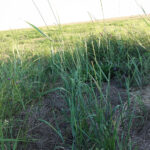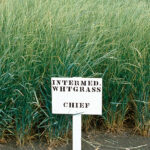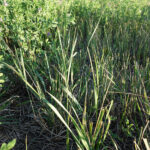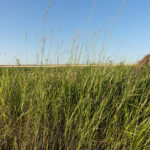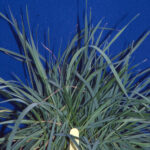Intermediate Wheatgrass
Thinopyrum intermedium
General Description
Intermediate wheatgrass and pubescent wheatgrass are tall, spreading, perennial grasses with high yield potential. Pubescent wheatgrass, with its hairy seed heads, is currently considered to be a type of intermediate wheatgrass instead of a separate forage species. Pubescent wheatgrass and intermediate wheatgrass are still often marketed as distinct species.
Intermediate wheatgrass forms deep, extensive fibrous roots with rhizomes of varying vigour so is often mistaken as a bunchgrass. Stems are 50 to 150 cm (20 to 60 in) tall. Leaves are blue-green to green and 2 to 10 mm wide with thickened and hardened margins. The seed heads are about 5 to 25 cm (2 to 10 in) long in a narrow-shaped spike. “Intermediate wheatgrass” produces smooth seed heads, while “pubescent wheatgrass” has fine hairs on the seed head. Suitable for drier sites with a variety of soils textures.
Type
Tame grass.
Origin
Central Europe, the Balkans, and Asia minor. Varieties developed in Canada.
Longevity
At least 10 years. Persistence is highly related to individual site conditions (longevity noted from 4-52 years).
Use
Hay, pasture, stockpiled. Generally short lived in grazing systems and longer lived in haying systems. Stockpile previously grazed or hayed intermediate wheatgrass. It has also been used in many applications of rangeland rehabilitation seeding as well as for erosion control.
Optimal Time of Use
Spring, summer, fall, winter. Plants should be allowed to reach a height of 20 cm (8 in) before grazing. Best grazed before stem elongation for palatability. Hay intermediate wheatgrass from early heading to flowering- generally later in the year than smooth bromegrass. If to be used as a stockpiled forage, intermediate wheatgrass should be used early in the season then stockpiled to maintain quality.
Recovery After Use
Requires a minimum 60-80 days of recovery after use. Regrowth can be vigorous in the spring with adequate residues (10 cm/4 in), moisture and fertility, however regrowth slows later in the season making it difficult to maintain in continuous or high frequency rotational grazing system. Grazing or cutting intermediate wheatgrass more than once per year will reduce stand vigour and persistence in the stand.
Palatability/Nutritional Value
Intermediate wheatgrass is highly palatable to livestock and wildlife. Typically, intermediate wheatgrass has crude protein of 12–15% at haying and protein may be as high as 11% later in the season. Intermediate wheatgrass matures later than other grasses, providing a high quality hay when it is grown in a mixture with a legume.
Annual Precipitation min/max (mm)
330mm / 1120mm
Drought Tolerance
Good tolerance. Some pubescent varieties have been noted to have higher drought tolerance.
Flooding Tolerance
Intermediate wheatgrass does not tolerate flooding, but can withstand submergence for about 1 week in the spring.
Winter Hardiness
Good hardiness.
Soil Texture Preference
Intermediate wheatgrass is best suited to well drained sandy-loam to clay soils.
Erosion Control
High ability to control erosion. Intermediate wheatgrass produces a dense deep root system, especially on moister sites. Root production may be reduced on drier sites.
Salinity Tolerance
Moderate tolerance.
Acidity Tolerance
Slight tolerance. Intermediate wheatgrass tolerates soil pH to 5.6.
Alkalinity Tolerance
Moderate to high tolerance.
Seeds per kg
176,500 seeds/kg (80,000 seeds/lb)
Suggested Mixtures
Intermediate wheatgrass mixes well with a legume for hay production.
Ease of Establishment
Intermediate wheatgrass establishes easily. Rhizomes will spread to fill in space between plants.
Competitiveness
Competitiveness has been variable depending on site conditions, and is thought to be less competitive than western wheatgrass. Its lack of competitiveness makes it a good candidate for mixing with legumes like alfalfa. Intermediate wheatgrass is not considered invasive, although in some situations it has been known to increase in sites where it is planted.
Management Considerations
Intermediate wheatgrass is not suited to continuous grazing. Successful pastures are usually managed for light grazing in a rotation with long rest periods. Hayed intermediate wheatgrass can be stockpile grazed successfully.
British Columbia Rangeland Seeding Manual, Saskatchewan Dryland Forage Species Adaptation Tool, USDA Plants Database, Alberta Forage Manual, Manitoba Forage Adaptation and Comparison Guide
Intermediate wheatgrass is adapted to all zones in the Central Interior, but is less adapted to the driest (semi-arid) parts of the bunchgrass zone in the southern part of the region.
Intermediate wheatgrass is adapted to all zones in the Southern Interior, but is less adapted to the driest (semi-arid) parts of the bunchgrass zone.
Intermediate wheatgrass is adapted to the Peace-Liard region, especially those varieties developed at Saskatoon, Saskatchewan (e.g., Chief and Clarke).
